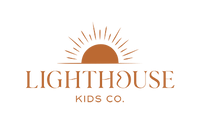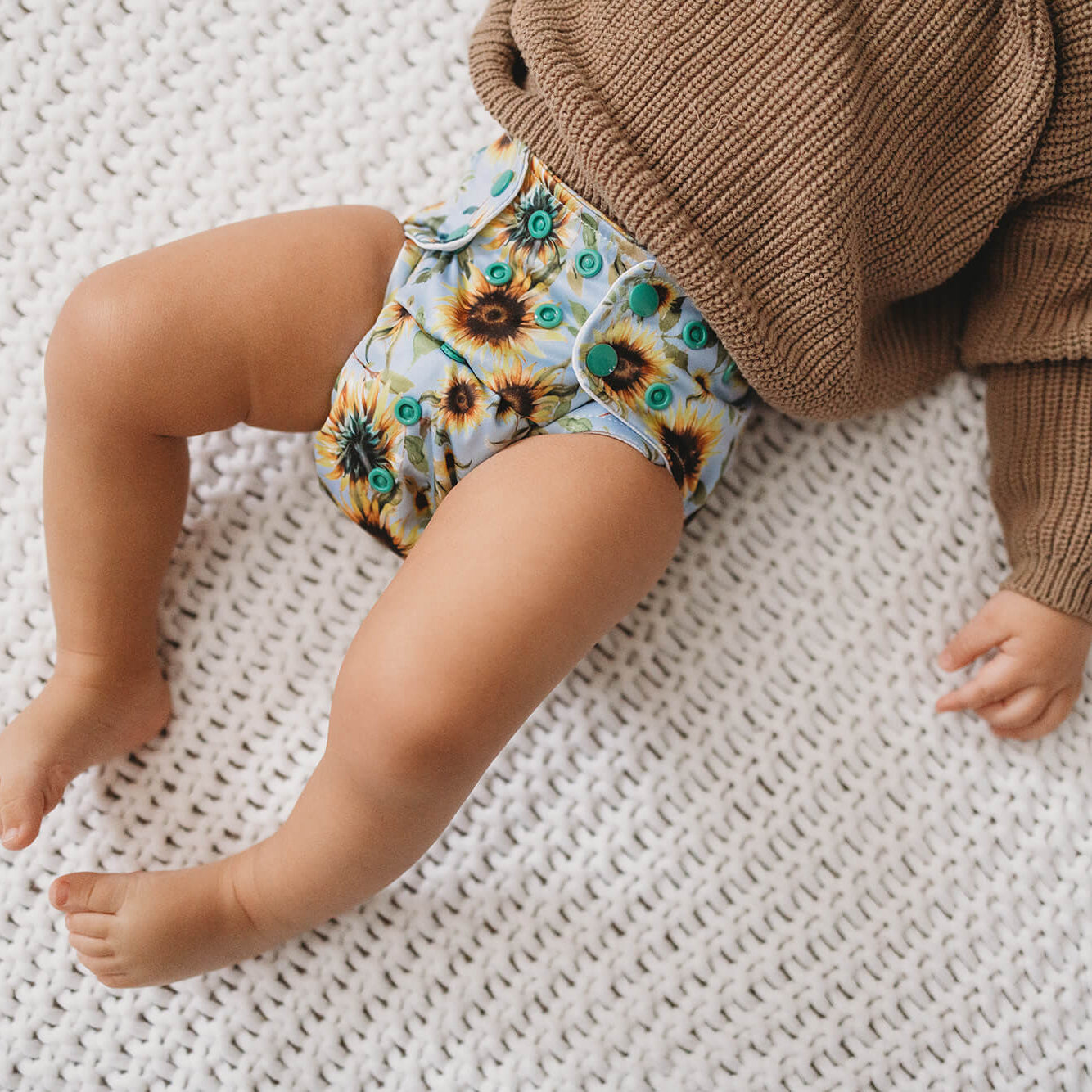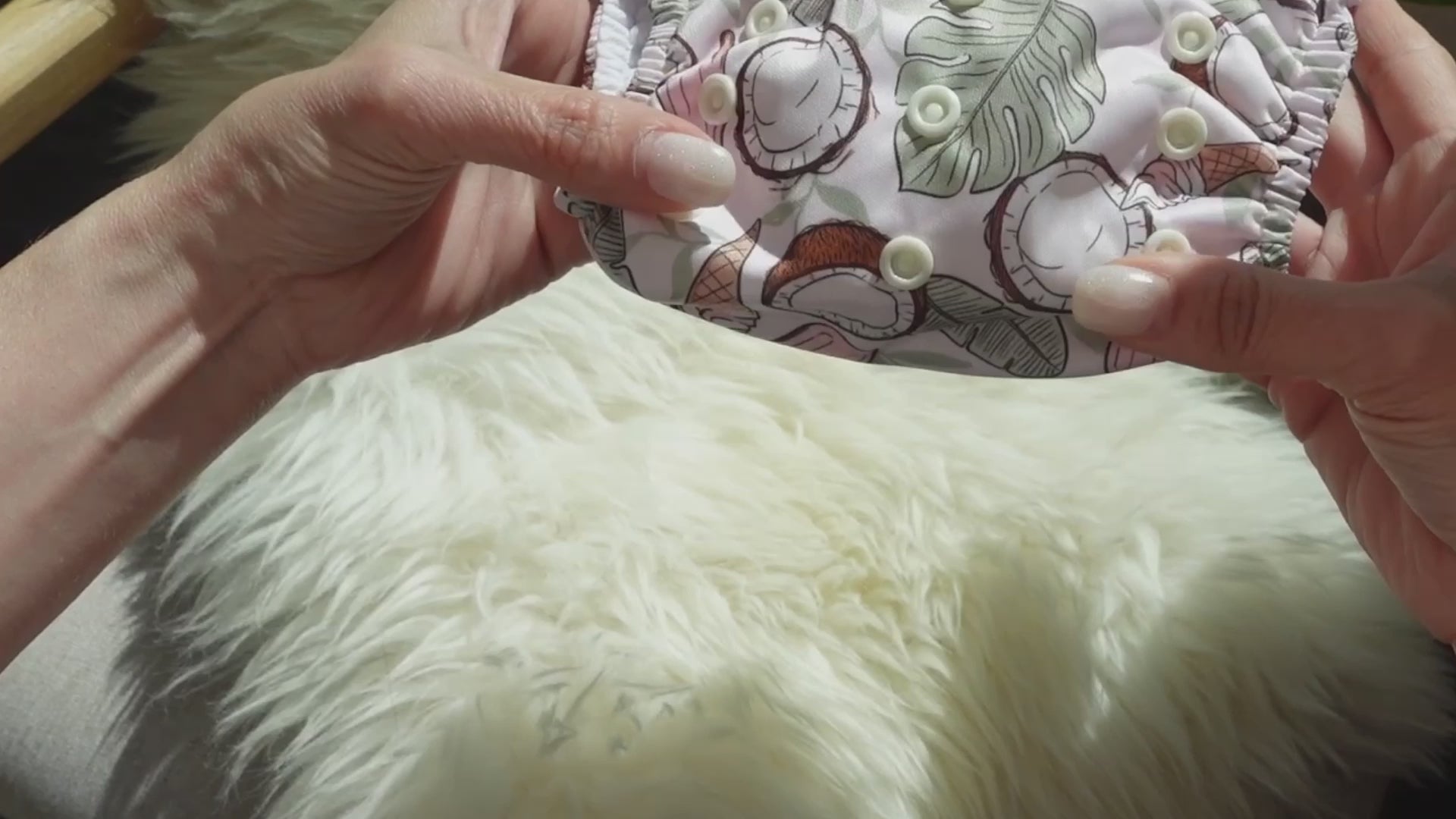Pocket diapers are a type of modern cloth diaper with a waterproof outer layer. These diapers have a pocket opening which allows for the insert to be stuffed inside.
Pocket diapers are an eco-friendly alternative to disposable diapers and are becoming increasingly popular with new parents. They are adjustable from birth to potty training.
The diapers are available in two different sizes. Size 1 is for newborns and thin babies, while Size 2 is for toddlers, chunky babies, or children with special needs.
Pocket diapers are easy to care for and can be washed and reused multiple times. With proper care, they can last for multiple babies or can be resold or donated when you are done cloth diapering.
Having a few different types of absorbent inserts on hand can help ensure that your baby never leaks or has blowouts.
Lighthouse Kids Company produces the best pocket cloth diapers. These diapers are made with a toxin-free TPU outer and a mesh Athletic Wicking Jersey (AWJ) inner.
Cloth diaper inserts are typically made of cotton, bamboo, or microfiber and come in a variety of sizes and thicknesses. We prefer bamboo inserts because of the excellent absorbency and cleanliness of the fabric.
Benefits of Pocket Diapers
Pocket diapers provide several benefits for parents looking for a reusable diapering option. Firstly, they are incredibly convenient and easy to use. They also offer flexibility in terms of fit, as the absorbent layer can be stuffed to the baby's needs.
If you have a heavy wetter you can add extra inserts, If you have a newborn, you can customize the absorbency with a smaller insert because they will be changed more frequently.
Pocket cloth diapers are more cost-effective than disposable diapers. With Lighthouse Kids Company diapers, you can save over $1,500 per child and never have to purchase disposables again.
Reduce Landfill Usage
It is estimated that using reusable cloth diapers can save around 4,000 to 6,000 disposable diapers per child. Imagine the environmental impact that will have on your baby's future.
Tips for Choosing the Right Pocket Diapers
Consider the type of fabric used for the diaper
The least eco-friendly part of a modern cloth diaper is the outer shell.
When searching for cloth diapers pocket, the most important thing to look for is a breathable outer layer made with TPU. This outer layer should be made from recycled fabric.
TPU or Thermoplastic Polyurethane is a more eco-friendly way of binding the water-resistant fabric to the polyester outer shell. All Lighthouse Kids pocket diapers are made with recycled TPU. This means you are getting a diaper free of lead, phthalates, and PFAS toxins.

Make sure the diaper is adjustable to fit your child’s size
Several cloth diaper brands are advertised as being one-size. However, it is challenging to achieve a proper fit when using them on both a newborn baby and a big toddler.
That's why having two sizes is helpful when choosing cloth diapers. Size 1 fits babies from 6-32lbs and Size 2 fits babies from 15-55lbs. Both sizes can be adjusted to grow with your baby.

Choose the right type of diaper inserts
When choosing inserts for your pocket cloth diapers, consider the following factors to find the right ones for your needs:
Absorbency: Look for inserts that offer the absorbency level suitable for your baby's age and needs. Newborns will need less absorbency compared to toddlers or heavy wetters. Microfiber, bamboo, hemp, or charcoal bamboo are common materials used for inserts, each with varying absorbency levels.
- We do not recommend Microfiber inserts as they tend to hold on to stink and cause compression leaks.
Trimness: If you prefer a trimmer fit, choose inserts that are less bulky like our bamboo diaper inserts. Bamboo inserts are typically thinner, while cotton or hemp inserts may be slightly bulkier.
Stay-Dry or Natural Fiber: Decide whether you want a stay-dry feeling against your baby's skin. Microfiber inserts provide a stay-dry effect, while natural fibers like bamboo or hemp offer a more natural, breathable option. Lighthouse Kids Inserts give you the option to keep your baby wet or dry. Simply flip the insert to the desired side.
Doublers or Boosters: Consider using additional doublers or boosters if your baby is a heavy wetter or for overnight use. These extra inserts can enhance absorbency and provide longer-lasting dryness.
Washing and Drying: Ensure the inserts you choose are easy to clean and quick to dry. Microfiber inserts tend to dry faster due to the man-made nature of the fabric. Bamboo or hemp are known for excellent absorbency but take a little longer to dry.
Size: Check if the inserts you have fit with the pocket diapers you own. Most inserts are designed to fit standard-sized pockets, but it's always a good idea to double-check.
Personal Preference: Finally, consider your personal preferences, such as eco-friendliness, cost-effectiveness, or any specific requirements you may have.
It's helpful to try different types of inserts to find the perfect combination that suits your baby's needs.
How to Wash Pocket Cloth Diapers
Washing pocket cloth diapers is essential to maintaining their cleanliness and longevity. Here's a general guide on how to wash pocket cloth diapers:
Get Rid of the Poop First
Start by removing any solid waste from the diaper. You can use a diaper sprayer, reusable, or disposable diaper liner, or simply dump the waste into the toilet.
Place the soiled pocket diapers into a diaper pail or wet bag until you're ready to wash them. It's a good idea to rinse the diapers with cold water before storing them to help prevent stains from setting.
If your baby is exclusively breastfed, you do not need to rinse your diapers first. Breastfed poop is 100% water soluble. This means you can toss the diaper straight into the washing machine.
Washing Pocket Diapers
When you're ready to wash the diapers, empty the contents of the diaper pail or wet bag into your washing machine. Make sure to remove any inserts from the pockets before washing.
- Run a cold pre-rinse cycle to remove any remaining waste and detergent residue. This helps to prevent odor and buildup. Detergent is not needed in this step.
- After this cycle is completed, run a hot wash cycle (60C/140F) with a detergent that contains enzymes. Follow the instructions for the recommended amount of detergent to use. Do NOT use small amounts as your diapers may not come out clean.
- Using the extra rinse cycle in your washing machine is recommended. This will ensure that all detergent is thoroughly rinsed out of the diapers.
- Once the final wash cycle is complete, hang the pocket diapers to dry or tumble dry them on low heat.
Do not use fabric softeners or dryer sheets. They can reduce the absorbency of the diapers. This happens because they coat the fabric with a thin film.
How to deal with Stains in Reusable Pocket Diapers
If you have stains, you can your diapers in direct sunlight for no more than 2 hours. This would be done after they are machine washed, but before they are dried.
Caution: If you leave your diapers in direct sunlight for extended periods, you can ruin your diapers. Please be careful when using this method.
Stubborn Stains
If your stains are particularly stubborn, you may use the Lemon Method. Squeeze lemon juice directly into the diaper stain (while the diaper is wet and clean from the wash). This will act as a bleaching agent and remove any stubborn stains. If you use the Lemon Method, make sure to re-wash your diapers before using them on the baby.
Pocket cloth diapers are an excellent choice for parents looking for an eco-friendly and cost-effective diapering solution. They are very easy to use and come in a range of sizes, from newborn to toddler. With so many options and prints available, Lighthouse Kids Company Pockets are the best pocket cloth diaper for your little one.
Need Some More Help With Cloth Diapers?
Connect with us LIVE here:
- Join our Facebook VIP Group for LIVE, gentle, cloth diaper support and new release spoilers.
- Join the cloth diaper conversation on TikTok.
- Be Inspired by cloth diapers on Instagram.
- Go down the diaper rabbit hole on YouTube.





































